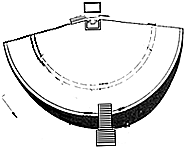

|
The Pnyx is the central of the three hills which lie in a line
south west of the Acropolis and the Areios Pagos. Situated between the hill of
the Nymphs and Muses, the Pnyx was the place where the Assembly of Athens
(Ekklesia) met after the reforms of Kleisthenes and Ephialtes by the
beginning of the
The Pnyx was the central symbol of the Assembly, of the Demos and of Democracy itself. It is here that all free adult male citizens of Athens gathered to discuss and vote on the most important matters of the city concerning cult, finance, elections, military and naval issues, foreigh policy and justice. Discussion subjects were placed on the agenda in the form of preliminary decrees by the Council (provouleumata). The resulting decrees started with the formula "edoxe tei bouli kai toi demoi" (It was decided by the Council and the people). By the fourth century BC, all participants were paid for attending the Assembly, a full compensation for half a day's lost employment.
The excavators have identified three main construction phases in
the area. During the first phase
|

|